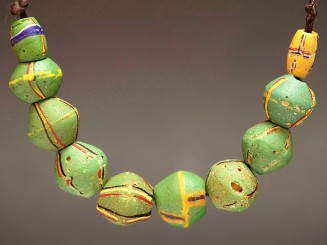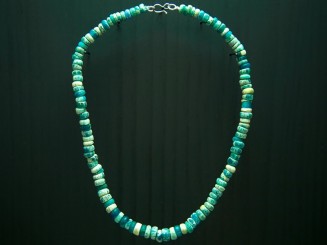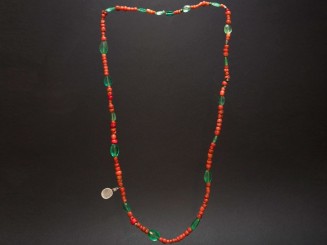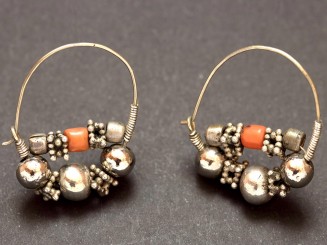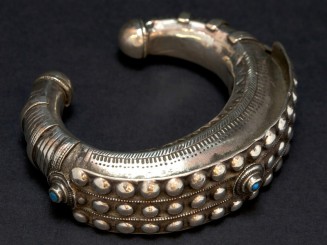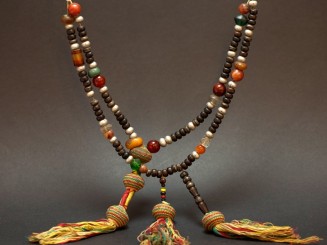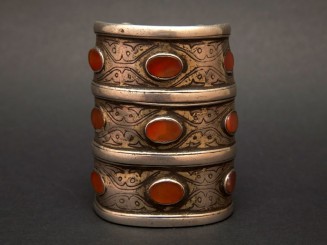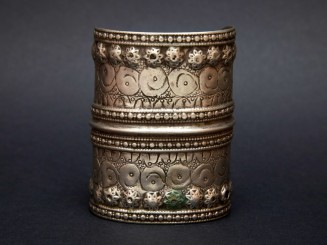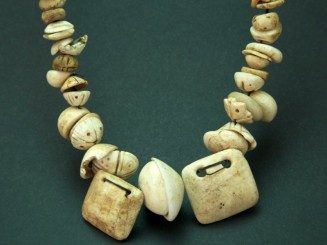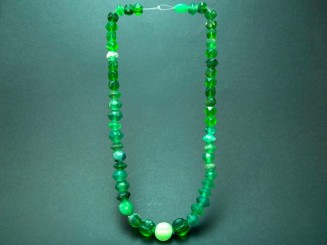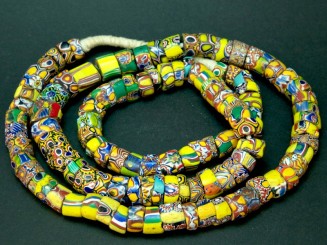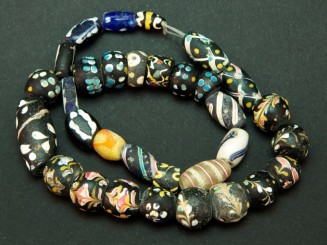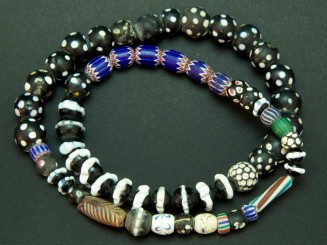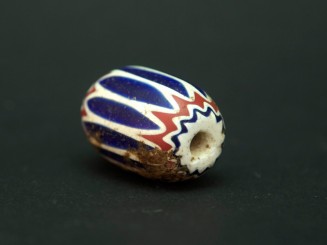
Jewels
-
Price €84.00MA1015-902
These beautiful Venetian trade glass biconical beads were made in Venice as from the beginning of the XIXth century using the lamp work technique. They were made in a variety of colors combining a opaque glass solid color core (yellow, burgundy, black, green, etc) on which linear decoration was applied in a lively combination of colors. These beads were known in the trade a “King beads” and also, locally, as Gololo beads. These beads were among the most important ones in the gold trade in the XIXth century in Africa. This strand features nine beautiful green King beads (one of them rather with a barrel shape) and, as a curiosity, an old local Krobo glass bead that imitates the “King bead” model.
The central bead is 15mm (long) and 15mm (diameter).
We use the term trade beads to refer to the European made glass beads that were used by the European merchants and explorers in the trade in Africa as from the 15th century and continued during their colonial expansion. The history of trade beads in Africa takes us then to the 15th century and the arrival of the European, mainly the Portuguese, to the coasts of West Africa. The European discovered quite soon how much the people they met there fancied beads and saw they an opportunity for trade. Amongst the beads that captivated the African people most were glass beads since the techniques for their making had not yet been developed locally. The locals fell for the precious and colorful glass beads such as Venetian millefiori or chevron beads that the European traders had on offer and bartered them for commodities such as precious woods, ivory, gold and even used, ignominiously, in the slave trade. The increasing demand in Africa of European made glass beads continued quite until the first half of the 20th century and it had a boosting effect in the production in cities such as Venice which glass beads became very popular and coveted.
Lamp working is one of the main techniques for the making of glass beads. Lamp or lamp work beads were made using glass canes that were reheated to a temperature of up to 1000 ºC by means of a blowtorch or blowlamp and which were then wound onto a coated iron rod to avoid the molten glass from sticking to the metal. The beads produced by the artisan by these means could be then further decorated by re-heating the bead using the same lamp work method and applying colored glass rods or glass cane inserts to the surface of the bead creating an endless variation of patterns and making of each bead one of its own.
-
Price €30.00MD0316-317
These lovely three Venetian trade glass biconical beads were made in Venice as from the beginning of the XIXth century using the lamp work technique. They were made in a variety of colors combining a opaque glass solid color core (yellow, burgundy, black, green, etc) on which linear decoration was applied in a lively combination of colors. These beads were known in the trade a “King beads” and also, locally, as Gololo beads. These beads were among the most important ones in the gold trade in Africa.
The central bead is 17mm long and 19mm diameter.
We use the term trade beads to refer to the European made glass beads that were used by the European merchants and explorers in the trade in Africa as from the 15th century and continued during their colonial expansion. The history of trade beads in Africa takes us then to the 15th century and the arrival of the European, mainly the Portuguese, to the coasts of West Africa. The European discovered quite soon how much the people they met there fancied beads and saw they an opportunity for trade. Amongst the beads that captivated the African people most were glass beads since the techniques for their making had not yet been developed locally. The locals fell for the precious and colorful glass beads such as Venetian millefiori or chevron beads that the European traders had on offer and bartered them for commodities such as precious woods, ivory, gold and even used, ignominiously, in the slave trade. The increasing demand in Africa of European made glass beads continued quite until the first half of the 20th century and it had a boosting effect in the production in cities such as Venice which glass beads became very popular and coveted.
Lamp working is one of the main techniques for the making of glass beads. Lamp or lamp work beads were made using glass canes that were reheated to a temperature of up to 1000 ºC by means of a blowtorch or blowlamp and which were then wound onto a coated iron rod to avoid the molten glass from sticking to the metal. The beads produced by the artisan by these means could be then further decorated by re-heating the bead using the same lamp work method and applying colored glass rods or glass cane inserts to the surface of the bead creating an endless variation of patterns and making of each bead one of its own.
-
Price €125.00MD0316-313
The model of these forty-two beautiful Venetian trade beads is without any doubt among those most popular in barter trade in West Africa. They were made at artisan workshops in Venice from the mid-1800s to the first third of the 19th century using the lamp work technique. The very typical eye or dotted decoration classes them as eye beads. The combination of white dots on a black background, though there are other combination of colors, made them known in the trade as “black and white skunk” as they reminded of the fur of this animal. In Spain they where also known as “Moorish” beads and where sometimes found as part of the jewellery arrangements of traditional “charra” jewellery from the province of Salamanca.
The larger bead measures approximately 12mm (long) and 14 mm (diameter).
We use the term trade beads to refer to the European made glass beads that were used by the European merchants and explorers in the trade in Africa as from the 15th century and continued during their colonial expansion. The history of trade beads in Africa takes us then to the 15th century and the arrival of the European, mainly the Portuguese, to the coasts of West Africa. The European discovered quite soon how much the people they met there fancied beads and saw they an opportunity for trade. Amongst the beads that captivated the African people most were glass beads since the techniques for their making had not yet been developed locally. The locals fell for the precious and colorful glass beads such as Venetian millefiori or chevron beads that the European traders had on offer and bartered them for commodities such as precious woods, ivory, gold and even used, ignominiously, in the slave trade. The increasing demand in Africa of European made glass beads continued quite until the first half of the 20th century and it had a boosting effect in the production in cities such as Venice which glass beads became very popular and coveted.
Eye glass beads are beads which main feature are circular decorations that remind of an eye made using lamp work, inset or mosaic techniques. One of the best examples of eye beads are found among Islamic beads mostly blue or green with white eyes as well as eye dotted Venetian glass beads (skunk). The eye decoration may be a simple eye or a number of them scattered on the surface of the bead, they may be plain ones or concentric ones using different colors. Eye beads may also present some linear trails, ziz-zag or floral decoration. Eye beads have been very much valued for centuries, actually they still are, among not only Islamic people but also African people as they were regarded as strong amulets to avert the evil eye and for their alleged prophylactic and magical properties.
Lamp working is one of the main techniques for the making of glass beads. Lamp or lamp work beads were made using glass canes that were reheated to a temperature of up to 1000 ºC by means of a blowtorch or blowlamp and which were then wound onto a coated iron rod to avoid the molten glass from sticking to the metal. The beads produced by the artisan by these means could be then further decorated by re-heating the bead using the same lamp work method and applying colored glass rods or glass cane inserts to the surface of the bead creating an endless variation of patterns and making of each bead one of its own.
-
Price €125.00MD0316-310
A superb set of twenty-eight Venetian trade lamp work glass beads commonly known as “Blue skunk”. These are among the rarest and oldest of their kind as they were made as from the very early years of the XIXth century in Venice. The very typical eye or dotted decoration classes them as eye beads. These ones are particularly valued as their fabrication required a high degree of dexterity to decorate each white eye with a blue translucent eye on relief on top which, besides, made them very sensible to wear and damage.
Approximate measures of larger bead: 12mm (long), 14mm (diameter).
We use the term trade beads to refer to the European made glass beads that were used by the European merchants and explorers in the trade in Africa as from the 15th century and continued during their colonial expansion. The history of trade beads in Africa takes us then to the 15th century and the arrival of the European, mainly the Portuguese, to the coasts of West Africa. The European discovered quite soon how much the people they met there fancied beads and saw they an opportunity for trade. Amongst the beads that captivated the African people most were glass beads since the techniques for their making had not yet been developed locally. The locals fell for the precious and colorful glass beads such as Venetian millefiori or chevron beads that the European traders had on offer and bartered them for commodities such as precious woods, ivory, gold and even used, ignominiously, in the slave trade. The increasing demand in Africa of European made glass beads continued quite until the first half of the 20th century and it had a boosting effect in the production in cities such as Venice which glass beads became very popular and coveted.
Eye glass beads are beads which main feature are circular decorations that remind of an eye made using lamp work, inset or mosaic techniques. One of the best examples of eye beads are found among Islamic beads mostly blue or green with white eyes as well as eye dotted Venetian glass beads (skunk). The eye decoration may be a simple eye or a number of them scattered on the surface of the bead, they may be plain ones or concentric ones using different colors. Eye beads may also present some linear trails, ziz-zag or floral decoration. Eye beads have been very much valued for centuries, actually they still are, among not only Islamic people but also African people as they were regarded as strong amulets to avert the evil eye and for their alleged prophylactic and magical properties.
Lamp working is one of the main techniques for the making of glass beads. Lamp or lamp work beads were made using glass canes that were reheated to a temperature of up to 1000 ºC by means of a blowtorch or blowlamp and which were then wound onto a coated iron rod to avoid the molten glass from sticking to the metal. The beads produced by the artisan by these means could be then further decorated by re-heating the bead using the same lamp work method and applying colored glass rods or glass cane inserts to the surface of the bead creating an endless variation of patterns and making of each bead one of its own.
-
Price €36.00MD0316-318
These twenty-one lovely Venetian trade lampwork eye glass beads of various color and designs are more common in East Africa than in Occidental Africa. Yet we have been lucky enough to find a mix of them in Mali, Mauritania and Morocco to make this beautiful stand. Made between the second half of the XIXth century and beginning of the XXth century.
The central (oval) bead is approximately 18mm (long) by 10mm (diameter).
We use the term trade beads to refer to the European made glass beads that were used by the European merchants and explorers in the trade in Africa as from the 15th century and continued during their colonial expansion. The history of trade beads in Africa takes us then to the 15th century and the arrival of the European, mainly the Portuguese, to the coasts of West Africa. The European discovered quite soon how much the people they met there fancied beads and saw they an opportunity for trade. Amongst the beads that captivated the African people most were glass beads since the techniques for their making had not yet been developed locally. The locals fell for the precious and colorful glass beads such as Venetian millefiori or chevron beads that the European traders had on offer and bartered them for commodities such as precious woods, ivory, gold and even used, ignominiously, in the slave trade. The increasing demand in Africa of European made glass beads continued quite until the first half of the 20th century and it had a boosting effect in the production in cities such as Venice which glass beads became very popular and coveted.
Eye glass beads are beads which main feature are circular decorations that remind of an eye made using lamp work, inset or mosaic techniques. One of the best examples of eye beads are found among Islamic beads mostly blue or green with white eyes as well as eye dotted Venetian glass beads (skunk). The eye decoration may be a simple eye or a number of them scattered on the surface of the bead, they may be plain ones or concentric ones using different colors. Eye beads may also present some linear trails, ziz-zag or floral decoration. Eye beads have been very much valued for centuries, actually they still are, among not only Islamic people but also African people as they were regarded as strong amulets to avert the evil eye and for their alleged prophylactic and magical properties.
Lamp working is one of the main techniques for the making of glass beads. Lamp or lamp work beads were made using glass canes that were reheated to a temperature of up to 1000 ºC by means of a blowtorch or blowlamp and which were then wound onto a coated iron rod to avoid the molten glass from sticking to the metal. The beads produced by the artisan by these means could be then further decorated by re-heating the bead using the same lamp work method and applying colored glass rods or glass cane inserts to the surface of the bead creating an endless variation of patterns and making of each bead one of its own.
-
Price €95.00MD0316-315
These twenty-one lovely Venetian trade lampwork eye glass beads of various color and designs are more common in East Africa than in Occidental Africa. Yet we have been lucky enough to find a mix of them in Mali, Mauritania and Morocco to make this beautiful stand. Made between the second half of the XIXth century and beginning of the XXth century.
The central (oval) bead is approximately 18mm (long) by 10mm (diameter).
We use the term trade beads to refer to the European made glass beads that were used by the European merchants and explorers in the trade in Africa as from the 15th century and continued during their colonial expansion. The history of trade beads in Africa takes us then to the 15th century and the arrival of the European, mainly the Portuguese, to the coasts of West Africa. The European discovered quite soon how much the people they met there fancied beads and saw they an opportunity for trade. Amongst the beads that captivated the African people most were glass beads since the techniques for their making had not yet been developed locally. The locals fell for the precious and colorful glass beads such as Venetian millefiori or chevron beads that the European traders had on offer and bartered them for commodities such as precious woods, ivory, gold and even used, ignominiously, in the slave trade. The increasing demand in Africa of European made glass beads continued quite until the first half of the 20th century and it had a boosting effect in the production in cities such as Venice which glass beads became very popular and coveted.
Eye glass beads are beads which main feature are circular decorations that remind of an eye made using lamp work, inset or mosaic techniques. One of the best examples of eye beads are found among Islamic beads mostly blue or green with white eyes as well as eye dotted Venetian glass beads (skunk). The eye decoration may be a simple eye or a number of them scattered on the surface of the bead, they may be plain ones or concentric ones using different colors. Eye beads may also present some linear trails, ziz-zag or floral decoration. Eye beads have been very much valued for centuries, actually they still are, among not only Islamic people but also African people as they were regarded as strong amulets to avert the evil eye and for their alleged prophylactic and magical properties.
Lamp working is one of the main techniques for the making of glass beads. Lamp or lamp work beads were made using glass canes that were reheated to a temperature of up to 1000 ºC by means of a blowtorch or blowlamp and which were then wound onto a coated iron rod to avoid the molten glass from sticking to the metal. The beads produced by the artisan by these means could be then further decorated by re-heating the bead using the same lamp work method and applying colored glass rods or glass cane inserts to the surface of the bead creating an endless variation of patterns and making of each bead one of its own.
-
Price €36.00MD0316-319
A charming and original set of Venetian trade lamp work galss beads from the beginning of the XXth century. The artisans would have found their inspiration to make them in ancient Islamic glass beads from the VIIth-XIIth centuries. The very peculiar pinched white crest decoration on a black glass core makes them quite often referred to as “dogteeth” or “ruffled” beads.
The larger bead is 10mm long and 10mm diameter.
We use the term trade beads to refer to the European made glass beads that were used by the European merchants and explorers in the trade in Africa as from the 15th century and continued during their colonial expansion. The history of trade beads in Africa takes us then to the 15th century and the arrival of the European, mainly the Portuguese, to the coasts of West Africa. The European discovered quite soon how much the people they met there fancied beads and saw they an opportunity for trade. Amongst the beads that captivated the African people most were glass beads since the techniques for their making had not yet been developed locally. The locals fell for the precious and colorful glass beads such as Venetian millefiori or chevron beads that the European traders had on offer and bartered them for commodities such as precious woods, ivory, gold and even used, ignominiously, in the slave trade. The increasing demand in Africa of European made glass beads continued quite until the first half of the 20th century and it had a boosting effect in the production in cities such as Venice which glass beads became very popular and coveted.
Lamp working is one of the main techniques for the making of glass beads. Lamp or lamp work beads were made using glass canes that were reheated to a temperature of up to 1000 ºC by means of a blowtorch or blowlamp and which were then wound onto a coated iron rod to avoid the molten glass from sticking to the metal. The beads produced by the artisan by these means could be then further decorated by re-heating the bead using the same lamp work method and applying colored glass rods or glass cane inserts to the surface of the bead creating an endless variation of patterns and making of each bead one of its own.
-
Price €30.00MD0316-309
A beautiful lamp work Venetian trade bead from the first half of the XIXth century. This type of beads are usually labelled as floral fancy decorated beads (fiorate or fiorà) due to its decorative motifs resembling flowers and branches. These particular ones are commonly known as "Lewis & Clark" beads as the first reference known of them being used in the trade are that of early American explorers, Meriwether Lewis and William Clark, who with their native guide Sacagawea went on a famous expedition from the east to the west coast of America on the very early years of the XIXth century.
Approximate measures: 27mm (long), 13mm (diameter).
We use the term trade beads to refer to the European made glass beads that were used by the European merchants and explorers in the trade in Africa as from the 15th century and continued during their colonial expansion. The history of trade beads in Africa takes us then to the 15th century and the arrival of the European, mainly the Portuguese, to the coasts of West Africa. The European discovered quite soon how much the people they met there fancied beads and saw they an opportunity for trade. Amongst the beads that captivated the African people most were glass beads since the techniques for their making had not yet been developed locally. The locals fell for the precious and colorful glass beads such as Venetian millefiori or chevron beads that the European traders had on offer and bartered them for commodities such as precious woods, ivory, gold and even used, ignominiously, in the slave trade. The increasing demand in Africa of European made glass beads continued quite until the first half of the 20th century and it had a boosting effect in the production in cities such as Venice which glass beads became very popular and coveted.
Lamp working is one of the main techniques for the making of glass beads. Lamp or lamp work beads were made using glass canes that were reheated to a temperature of up to 1000 ºC by means of a blowtorch or blowlamp and which were then wound onto a coated iron rod to avoid the molten glass from sticking to the metal. The beads produced by the artisan by these means could be then further decorated by re-heating the bead using the same lamp work method and applying colored glass rods or glass cane inserts to the surface of the bead creating an endless variation of patterns and making of each bead one of its own.
-
Price €645.00MD1215-900
A truly awesome strand mixing an amazing selection of 57 antique Islamic glass eye lamp work beads sourced in Mali in the region south of the Niger river between the cities of Mopti and Gao. They have been buried for hundreds of years hence their wear, wonderful patina and strong character. Their colors range from different shades of blue from dark blue to aquamarine and tones of green.
When referring to Islamic beads we follow bead expert Robert K. Liu’s description in Ornament Magazine: “The term Islamic Period Glass Beads is used, similarly to Roman Period Beads, to classify groups of ornaments from specific geographic areas and time periods, with recognizable characteristics including patterns and techniques. In the case of Islamic glass beads we know they originated in the Middle East and flourished mostly between the seventh and twelfth centuries. Their designs display a wide mix of techniques and styles: millefiori/mosaic (including pierced mosaic pad beads), trailed, filigreed, combed, fused rods, segmented/blown, folded (an Islamic innovation, Holland and Holland 2006) and those derived from amulet shapes, like charmcase beads with loops.” Islamic glass beads travelled from their sources of production in the Middle and Near East together with the expansion of Islam to North Africa, Southern Europe (Spain), India and the Far East and they reached areas well beyond Islam’s actual limits of expansion such as Northern Europe. They also flowed into Sub-Saharan Africa, where they were valued and cherished for centuries in the Malian ancient kingdoms as a symbol of status and played an important role in the communities’ rites and ceremonies such a burials, initiation or dowries.
Eye glass beads are beads which main feature are circular decorations that remind of an eye made using lamp work, inset or mosaic techniques. One of the best examples of eye beads are found among Islamic beads mostly blue or green with white eyes as well as eye dotted Venetian glass beads (skunk). The eye decoration may be a simple eye or a number of them scattered on the surface of the bead, they may be plain ones or concentric ones using different colors. Eye beads may also present some linear trails, ziz-zag or floral decoration. Eye beads have been very much valued for centuries, actually they still are, among not only Islamic people but also African people as they were regarded as strong amulets to avert the evil eye and for their alleged prophylactic and magical properties.
-
Price €45.00MD0316-316
A set of eleven lovely Venetian chevron trade glass beads. They have a lovely combination of blue, white and red colors. One of the beads has a lovely striped green decoration which reminds of a small watermelon.
European glass chevron trade beads were certainly the first to be traded in Africa as early the 15th century. They show a very characteristic “rosetta” o “star” layered decoration attained by giving form to glass in star shaped moulds. Layer after layer are applied to form a cane which is then cut in cylinders and ground to show the alternated chevron or star layers. They were first produced in the Venetian island of Murano at the Barovier glass factory. The rarest examples are very much coveted and they are quite commonly tagged by the number of layers they show.
We use the term trade beads to refer to the European made glass beads that were used by the European merchants and explorers in the trade in Africa as from the 15th century and continued during their colonial expansion. The history of trade beads in Africa takes us then to the 15th century and the arrival of the European, mainly the Portuguese, to the coasts of West Africa. The European discovered quite soon how much the people they met there fancied beads and saw they an opportunity for trade. Amongst the beads that captivated the African people most were glass beads since the techniques for their making had not yet been developed locally. The locals fell for the precious and colorful glass beads such as Venetian millefiori or chevron beads that the European traders had on offer and bartered them for commodities such as precious woods, ivory, gold and even used, ignominiously, in the slave trade. The increasing demand in Africa of European made glass beads continued quite until the first half of the 20th century and it had a boosting effect in the production in cities such as Venice which glass beads became very popular and coveted.
-
Price €65.00MD0315-387
A beautiful necklace made with a superb combination of antique Islamic Nila glass beads sourced in Mali. The size of these beads is somewhat larger than usual and are locally know as “Dardig”. Nila beads are small monochrome Islamic glass beads than can be found in colors ranging mostly from blue, green and white to yellow were quite widespread in West Africa. They are also referred to as Indo-Pacific or Trade Winds beads in reference to the winds that for centuries were used by the merchant ships bringing them from India. Large quantities of these small and charming beads have been found in archaeological sities along the river banks of the Niger river in Mali where sometimes not only beads but also hollow canes have been found to produce them locally. The word Nila would come from the Sanskrit term for indigo.
When referring to Islamic beads we follow bead expert Robert K. Liu’s description in Ornament Magazine: “The term Islamic Period Glass Beads is used, similarly to Roman Period Beads, to classify groups of ornaments from specific geographic areas and time periods, with recognizable characteristics including patterns and techniques. In the case of Islamic glass beads we know they originated in the Middle East and flourished mostly between the seventh and twelfth centuries. Their designs display a wide mix of techniques and styles: millefiori/mosaic (including pierced mosaic pad beads), trailed, filigreed, combed, fused rods, segmented/blown, folded (an Islamic innovation, Holland and Holland 2006) and those derived from amulet shapes, like charmcase beads with loops.” Islamic glass beads travelled from their sources of production in the Middle and Near East together with the expansion of Islam to North Africa, Southern Europe (Spain), India and the Far East and they reached areas well beyond Islam’s actual limits of expansion such as Northern Europe. They also flowed into Sub-Saharan Africa, where they were valued and cherished for centuries in the Malian ancient kingdoms as a symbol of status and played an important role in the communities’ rites and ceremonies such a burials, initiation or dowries.
-
Price €275.00MD1115-415
This is a great set of ten antique Islamic glass eye lamp work beads sourced in Mali in the region south of the Niger river between the cities of Mopti and Gao. Though they have been buried for hundreds of years they show a nice condition and a wonderful patina. Their colors range from different shades of blue from dark blue (almost black) to aquamarine. Some of them show some band decoration which adds to their appeal.
The dimensions range from a diameter of 17 mm for the larger bead to 12mm for the smaller one.
When referring to Islamic beads we follow bead expert Robert K. Liu’s description in Ornament Magazine: “The term Islamic Period Glass Beads is used, similarly to Roman Period Beads, to classify groups of ornaments from specific geographic areas and time periods, with recognizable characteristics including patterns and techniques. In the case of Islamic glass beads we know they originated in the Middle East and flourished mostly between the seventh and twelfth centuries. Their designs display a wide mix of techniques and styles: millefiori/mosaic (including pierced mosaic pad beads), trailed, filigreed, combed, fused rods, segmented/blown, folded (an Islamic innovation, Holland and Holland 2006) and those derived from amulet shapes, like charmcase beads with loops.” Islamic glass beads travelled from their sources of production in the Middle and Near East together with the expansion of Islam to North Africa, Southern Europe (Spain), India and the Far East and they reached areas well beyond Islam’s actual limits of expansion such as Northern Europe. They also flowed into Sub-Saharan Africa, where they were valued and cherished for centuries in the Malian ancient kingdoms as a symbol of status and played an important role in the communities’ rites and ceremonies such a burials, initiation or dowries.
Eye glass beads are beads which main feature are circular decorations that remind of an eye made using lamp work, inset or mosaic techniques. One of the best examples of eye beads are found among Islamic beads mostly blue or green with white eyes as well as eye dotted Venetian glass beads (skunk). The eye decoration may be a simple eye or a number of them scattered on the surface of the bead, they may be plain ones or concentric ones using different colors. Eye beads may also present some linear trails, ziz-zag or floral decoration. Eye beads have been very much valued for centuries, actually they still are, among not only Islamic people but also African people as they were regarded as strong amulets to avert the evil eye and for their alleged prophylactic and magical properties.
-
Price €55.00MD0316-300
A set of six fantastic lamp work Venetian fiorà trade beads from the first half of the XIXth century. Their name comes from their characteristic floral or flower decoration that in a captivating array of colors and motifs is distributed on the main body of the bead which, in this particular case, is of a nice opaque black color. Lovely wear.
Approximate measures (larger bead): 12mm x 12mm.
Also referred to as decorated fancy beads, fiorate or fiorà, these Venetian lamp work glass trade beads are amongst the most attractive we may find. Their main feature is their flamboyant and joyful floral or flower decoration using a rich variety of colors and patterns: feather, bow tie, bouquet, dots, spiral (here we have to mention the well-known Lewis & Clark beads named after the explorers who first traded them with the tribes they found on their expedition from the East to the West coast of the United States in the early 1800s), linear, filigree, etc. They were mainly produced as from the first half of the 19th century. They are usually round or oval shaped.
We use the term trade beads to refer to the European made glass beads that were used by the European merchants and explorers in the trade in Africa as from the 15th century and continued during their colonial expansion.The history of trade beads in Africa takes us then to the 15th century and the arrival of the European, mainly the Portuguese, to the coasts of West Africa. The European discovered quite soon how much the people they met there fancied beads and saw they an opportunity for trade. Amongst the beads that captivated the African people most were glass beads since the techniques for their making had not yet been developed locally. The locals fell for the precious and colorful glass beads such as Venetian millefiori or chevron beads that the European traders had on offer and bartered them for commodities such as precious woods, ivory, gold and even used, ignominiously, in the slave trade. The increasing demand in Africa of European made glass beads continued quite until the first half of the 20th century and it had a boosting effect in the production in cities such as Venice which glass beads became very popular and coveted.
-
Price €65.00MD0316-298
Funky!. This is the word that comes first to our mind when admiring this great set of five lovely lamp work Venetian fiorà trade beads from the first half of the XIXth century. Their name comes from their characteristic floral or flower decoration that in a superb combination of colors and motifs is distributed on the main body of the bead which, in this particular case, is of a nice opaque black color. The central bead also shows a central band in aventurine which gives it a glittering mettallic effect.
Approximate dimensions (central bead): 12mm x 12mm.
Also referred to as decorated fancy beads, fiorate or fiorà, these Venetian lamp work glass trade beads are amongst the most attractive we may find. Their main feature is their flamboyant and joyful floral or flower decoration using a rich variety of colors and patterns: feather, bow tie, bouquet, dots, spiral (here we have to mention the well-known Lewis & Clark beads named after the explorers who first traded them with the tribes they found on their expedition from the East to the West coast of the United States in the early 1800s), linear, filigree, etc. They were mainly produced as from the first half of the 19th century. They are usually round or oval shaped.
We use the term trade beads to refer to the European made glass beads that were used by the European merchants and explorers in the trade in Africa as from the 15th century and continued during their colonial expansion.The history of trade beads in Africa takes us then to the 15th century and the arrival of the European, mainly the Portuguese, to the coasts of West Africa. The European discovered quite soon how much the people they met there fancied beads and saw they an opportunity for trade. Amongst the beads that captivated the African people most were glass beads since the techniques for their making had not yet been developed locally. The locals fell for the precious and colorful glass beads such as Venetian millefiori or chevron beads that the European traders had on offer and bartered them for commodities such as precious woods, ivory, gold and even used, ignominiously, in the slave trade. The increasing demand in Africa of European made glass beads continued quite until the first half of the 20th century and it had a boosting effect in the production in cities such as Venice which glass beads became very popular and coveted.
Aventurine refers to a caramel or brown coloured glass paste with a captivating metallic reflection used to decorate European trade glass beads and which, apparently, was only discovered by accident in the early 17th century.
-
Price €75.00MD0316-297
We can think of Alice wandering Wonderland wearing a necklace made of a combination of these awesome glass beads. This is a set of seven superb lamp work Venetian fiorà trade beads from the first half of the XIXth century. Their name comes from their characteristic floral or flower decoration that in a captivating array of colors (pink, yellow, white-lattimo) and motifs is distributed on the main body of the bead which, in this particular case, is of a nice dark green color.
Approximate measures (larger bead): 12mm x 14mm.
Also referred to as decorated fancy beads, fiorate or fiorà, these Venetian lamp work glass trade beads are amongst the most attractive we may find. Their main feature is their flamboyant and joyful floral or flower decoration using a rich variety of colors and patterns: feather, bow tie, bouquet, dots, spiral (here we have to mention the well-known Lewis & Clark beads named after the explorers who first traded them with the tribes they found on their expedition from the East to the West coast of the United States in the early 1800s), linear, filigree, etc. They were mainly produced as from the first half of the 19th century. They are usually round or oval shaped.
We use the term trade beads to refer to the European made glass beads that were used by the European merchants and explorers in the trade in Africa as from the 15th century and continued during their colonial expansion.The history of trade beads in Africa takes us then to the 15th century and the arrival of the European, mainly the Portuguese, to the coasts of West Africa. The European discovered quite soon how much the people they met there fancied beads and saw they an opportunity for trade. Amongst the beads that captivated the African people most were glass beads since the techniques for their making had not yet been developed locally. The locals fell for the precious and colorful glass beads such as Venetian millefiori or chevron beads that the European traders had on offer and bartered them for commodities such as precious woods, ivory, gold and even used, ignominiously, in the slave trade. The increasing demand in Africa of European made glass beads continued quite until the first half of the 20th century and it had a boosting effect in the production in cities such as Venice which glass beads became very popular and coveted.
-
Price €75.00MD0316-296
Oh my!. They are so sweet that we cannot but think of candy. A great set of seven eye-catching lamp work Venetian fiorà trade beads from the first half of the XIXth century. Their name comes from their characteristic floral or flower decoration that in a captivating array of colors and motifs is distributed on the main body of the bead which, in this particular case, is of a nice translucent red color which allows to see the main white core of the beads (white hearts).
Approximate measures (central bead). 11mm x 13mm.
Also referred to as decorated fancy beads, fiorate or fiorà, these Venetian lamp work glass trade beads are amongst the most attractive we may find. Their main feature is their flamboyant and joyful floral or flower decoration using a rich variety of colors and patterns: feather, bow tie, bouquet, dots, spiral (here we have to mention the well-known Lewis & Clark beads named after the explorers who first traded them with the tribes they found on their expedition from the East to the West coast of the United States in the early 1800s), linear, filigree, etc. They were mainly produced as from the first half of the 19th century. They are usually round or oval shaped.
We use the term trade beads to refer to the European made glass beads that were used by the European merchants and explorers in the trade in Africa as from the 15th century and continued during their colonial expansion.The history of trade beads in Africa takes us then to the 15th century and the arrival of the European, mainly the Portuguese, to the coasts of West Africa. The European discovered quite soon how much the people they met there fancied beads and saw they an opportunity for trade. Amongst the beads that captivated the African people most were glass beads since the techniques for their making had not yet been developed locally. The locals fell for the precious and colorful glass beads such as Venetian millefiori or chevron beads that the European traders had on offer and bartered them for commodities such as precious woods, ivory, gold and even used, ignominiously, in the slave trade. The increasing demand in Africa of European made glass beads continued quite until the first half of the 20th century and it had a boosting effect in the production in cities such as Venice which glass beads became very popular and coveted.
-
Price €130.00MA1015-382
A superb set of thirty-five antique Venetian glass trade beads from the begginning of the XIXth century. Very distintictive white swirls decoration on a black body. They are commonly referred in the trade as tire beads due to their shape and rattesnake beads as their decoration somewhat reminds of the rattle of those snakes. They are quite difficult to find, particularly the two ones showing a broad bright yellow stripe and a narrower middle red one. Approximate dimensions (larger one): length: 11mm, diameter 14mm.
We use the term trade beads to refer to the European made glass beads that were used by the European merchants and explorers in the trade in Africa as from the 15th century and continued during their colonial expansion. The history of trade beads in Africa takes us then to the 15th century and the arrival of the European, mainly the Portuguese, to the coasts of West Africa. The European discovered quite soon how much the people they met there fancied beads and saw they an opportunity for trade. Amongst the beads that captivated the African people most were glass beads since the techniques for their making had not yet been developed locally. The locals fell for the precious and colorful glass beads such as Venetian millefiori or chevron beads that the European traders had on offer and bartered them for commodities such as precious woods, ivory, gold and even used, ignominiously, in the slave trade. The increasing demand in Africa of European made glass beads continued quite until the first half of the 20th century and it had a boosting effect in the production in cities such as Venice which glass beads became very popular and coveted.
Lamp working is one of the main techniques for the making of glass beads. Lamp or lamp work beads were made using glass canes that were reheated to a temperature of up to 1000 ºC by means of a blowtorch or blowlamp and which were then wound onto a coated iron rod to avoid the molten glass from sticking to the metal. The beads produced by the artisan by these means could be then further decorated by re-heating the bead using the same lamp work method and applying colored glass rods or glass cane inserts to the surface of the bead creating an endless variation of patterns and making of each bead one of its own.
-
Price €55.00ET0310-305
A great assortment of 11 antique Ethipian amulet-beads or -telsum-. They are made of silver alloy and feature a beautiful patina. They would protect their wearer against evil eye and ward off any other evil influences.Different sizes.
-
Price €22.00ET0310-304
Three antique Ethipian amulet-beads or -telsum-. They are made of silver alloy and feature a beautiful patina.They would protect their wearer against evil eye and ward off any other evil influences.
-
Price €365.00MA1015-358
A charming old Moroccan necklace from the Rif region in the north of the country. It is made of coral beads, six red glass beads, lovely bicone green glass beads and a dangle made of an old silver coin. Rare, simple, elegant and .... so wearable!
-
Price €95.00MD0216-243
A beautiful set of Afghani old silver and coral beads earrings. Their design remind of Uzbek and Tajik examples. Very original.
-
-PK0116-194
A gorgeous silver old anklet from the Kuchi nomad group inhabiting large areas of Afghanistan and Pakistan. It features a wonderful engraved decoration as well as serie of bell dangles that make a wonderful rattle noise when moving. Similar examples can be found in Yemen though they usually miss the floral decoration. Great patina. Extralarge size.
-
-PK0116-208
A superb Kuchi old silver bracelet from Afghanistan. It features a great and attractive chiselling and embossing silverwork. It probably was not only an ornament but also served defense purposes. Wonderful patina.The Kuchi people, from the Persian -koch- meaning migration, are Afghan pashtoons nomads divided in a number of tribes that inhabit areas of Afghanistan and, to a lesser extent, Pakistan. Their jewellery is quite often very colourful using silver, glass and, in some fewer cases, enamel. It has become extremely popular among those practising traditional oriental dances and -belly-dancing-. First half of the XXth century.
-
Price €120.00MA0116-616
A rosary "tisbeh" from Mauritania. It is formed by a strand of old black ebony beads (some of them with silver filigree) and aluminium, and some others old glass beads of different sizes, types and colours and three true amber beads. The "tisbeh" is also decorated with three cotton tassels. Other names: "tasbih", "sebha", "mishat", "subhan"
-
Price €545.00MD1115-423
A beautiful antique silver cuff from the Turkmen tribe of the Tekke inhabiting Turkmenistan and neigbouring countries such as Afghanistan. Its is ornated with carnelians and features a characteristic engraved decoration. It shows some traces of fire gilding and a superb patina. A piece full of character. It does not bend much so please make sure it will fit your wrist!.
-
Price €280.00MD1115-419
A great antique silver cuff from the Turkmen tribe of the Ersari. The Ersari is one of the main five Turkmen tribes inhabiting Turkmenistan and some neighboring countries. It shows a beautiful engraved decoration and a lovely patina. It is not very flexible so please make sure it will fit you!.
-
Price €265.00MD1114-031
A beautiful strand of sixty five antique African trade glass beads in blue range color. Fantastic.
Beads have fascinated men all over the world for thousands of years. From the simplest ones made of clay, bone or horn to those made of metal, amber or glass or the most luxurious ones using precious stones and metals and where the result may sometimes be true pieces of art. Phoenicia, India, China, Rome, Tibet, Egypt, Mali, the Middle East, Mauritania, Venice, Persia, South America. You name it. Africa is not an exception to this. For centuries beads were used in Africa not only as pieces of adornment or status but, in many cases, as currency to trade a vast array of commodities (gold, ivory, exotic wood, etc.). Europe supplied the continent for hundreds of years with beads made in Murano, Bohemia, Germany, etc that mixed with those produced locally and others coming from lands farther beyond. All these beads, their awesome variety of designs, shapes, qualities, techniques, colors, material and origins have created a fascinating world that still subsists today and where we are not only captivated by what meets our eyes but also by the long and amazing history behind.
-
Price €95.00MD1114-026
Beads have fascinated men all over the world for thousands of years. From the simplest ones made of clay, bone or horn to those made of metal, amber or glass or the most luxurious ones using precious stones and metals and where the result may sometimes be true pieces of art. Phoenicia, India, China, Rome, Tibet, Egypt, Mali, the Middle East, Mauritania, Venice, Persia, South America. You name it. Africa is not an exception to this. For centuries beads were used in Africa not only as pieces of adornment or status but, in many cases, as currency to trade a vast array of commodities (gold, ivory, exotic wood, etc.). Europe supplied the continent for hundreds of years with beads made in Murano, Bohemia, Germany, etc that mixed with those produced locally and others coming from lands farther beyond. All these beads, their awesome variety of designs, shapes, qualities, techniques, colors, material and origins have created a fascinating world that still subsists today and where we are not only captivated by what meets our eyes but also by the long and amazing history behind.
Here we have now a marvelous strand of 59 old African glass trade beads from Europe, most likely Venice, known as black and white skunk beads.
-
Price €85.00MA0315-547
A beautiful Moroccan Berber or Maure necklace made of a superb combination of antique carved shell beads. Oustanding patina and very, very original.
-
Price €75.00MD0315-778
A beautiful set of old Bohemian glass “vaseline” beads sourced in Mali.Beads have fascinated men all over the world for thousands of years. From the simplest ones made of clay, bone or horn to those made of metal, amber or glass or the most luxurious ones using precious stones and metals and where the result may sometimes be true pieces of art. Phoenicia, India, China, Rome, Tibet, Egypt, Mali, the Middle East, Mauritania, Venice, Persia, South America. You name it. Africa is not an exception to this. For centuries beads were used in Africa not only as pieces of adornment or status but, in many cases, as currency to trade a vast array of commodities (gold, ivory, exotic wood, etc.). Europe supplied the continent for hundreds of years with beads made in Murano, Bohemia, Germany, etc that mixed with those produced locally and others coming from lands farther beyond. All these beads, their awesome variety of designs, shapes, qualities, techniques, colors, material and origins have created a fascinating world that still subsists today and where we are not only captivated by what meets our eyes but also by the long and amazing history behind.
-
Price €72.00MD1214-046
A great set of vintage Pashtoon or Turkoman tassels from Afghanistan. They were most likely part of a headdress or of a traditional frock coat. It could have also been used as part of the traditional harness of a horse. The tassels are made of beautifully worked metal domes with hanging fringe ending in tiny blue beads. A remarkable tribal piece.
-
Price €210.00MA0315-666
A superb strand of mixed old Murano glass beads, among them, the so-called millefiori (lit. thousand flowers) and mosaic. European glass trade beads became extremely popular in Africa. They were commonly used in barter transactions in exchange for a wide range of commodities from ivory or palm oil to gold. Venetian glass trade beads were among the most reputed ones both for the mastery in their manufacture as well as for the nearly endless combination of designs and colors. About the end of the XVth century most of the production of Venetian glass beads moved to the island of Murano were the drawn technique was recovered so that boosting the production as compared to the slower wound technique. Some other techniques were also used: molded, blown, wound-on-drawn. Some chips and dents commensurate with age. A beautiful combination of trade beads.
-
Price €150.00MA0315-668
A beautiful strand of mixed old Murano glass beads, among them, the so-called millefiori (lit. thousand flowers), mosaic and chevron. European glass trade beads became extremely popular in Africa. They were commonly used in barter transactions in exchange for a wide range of commodities from ivory or palm oil to gold. Venetian glass trade beads were among the most reputed ones both for the mastery in their manufacture as well as for the nearly endless combination of designs and colors. About the end of the XVth century most of the production of Venetian glass beads moved to the island of Murano were the drawn technique was recovered so that boosting the production as compared to the slower wound technique. Some other techniques were also used: molded, blown, wound-on-drawn. Some chips and dents commensurate with age. A beautiful combination of trade beads.
-
Price €240.00MD1114-030
A superb strand of antique African trade glass beads from differente origins: Ivory Coast, Cameroon, Mali, Ghana and Europe, among other. A colorful and awesome combination of patterns (millefiori, feather, etc), colors and shapes of captivating beauty and originality.
Beads have fascinated men all over the world for thousands of years. From the simplest ones made of clay, bone or horn to those made of metal, amber or glass or the most luxurious ones using precious stones and metals and where the result may sometimes be true pieces of art. Phoenicia, India, China, Rome, Tibet, Egypt, Mali, the Middle East, Mauritania, Venice, Persia, South America. You name it. Africa is not an exception to this. For centuries beads were used in Africa not only as pieces of adornment or status but, in many cases, as currency to trade a vast array of commodities (gold, ivory, exotic wood, etc.). Europe supplied the continent for hundreds of years with beads made in Murano, Bohemia, Germany, etc that mixed with those produced locally and others coming from lands farther beyond. All these beads, their awesome variety of designs, shapes, qualities, techniques, colors, material and origins have created a fascinating world that still subsists today and where we are not only captivated by what meets our eyes but also by the long and amazing history behind.
-
Price €145.00MD1114-028
A great combination of old African trade glass beads from different provenances: Cameroon, Ivoy Coast, Mali and Europe, among other. A captivating combination of colors and designs (chevron, skunk, feather) to a wonderful and eyec-catching result that pays tribute to the history of beads.
Beads have fascinated men all over the world for thousands of years. From the simplest ones made of clay, bone or horn to those made of metal, amber or glass or the most luxurious ones using precious stones and metals and where the result may sometimes be true pieces of art. Phoenicia, India, China, Rome, Tibet, Egypt, Mali, the Middle East, Mauritania, Venice, Persia, South America. You name it. Africa is not an exception to this. For centuries beads were used in Africa not only as pieces of adornment or status but, in many cases, as currency to trade a vast array of commodities (gold, ivory, exotic wood, etc.). Europe supplied the continent for hundreds of years with beads made in Murano, Bohemia, Germany, etc that mixed with those produced locally and others coming from lands farther beyond. All these beads, their awesome variety of designs, shapes, qualities, techniques, colors, material and origins have created a fascinating world that still subsists today and where we are not only captivated by what meets our eyes but also by the long and amazing history behind.
-
Price €75.00MD1114-035
Chevron beads, like this old example, are no doubt among the most popular glass beads used in the African trade for centuries. That is true not only because of its very characteristic design, beauty, lovely varieties but also because the high prices that the oldest examples can fetch. The first known date back to the end of the XVth century or beginning of the XVIth century and were manufactured in Venice. These beads are cane or drawn glass beads made by blowing glass into mold with corrugated sides several times to create a wonderful variation of designs to which sometimes stripes are also applied.
Beads have fascinated men all over the world for thousands of years. From the simplest ones made of clay, bone or horn to those made of metal, amber or glass or the most luxurious ones using precious stones and metals and where the result may sometimes be true pieces of art. Phoenicia, India, China, Rome, Tibet, Egypt, Mali, the Middle East, Mauritania, Venice, Persia, South America. You name it. Africa is not an exception to this. For centuries beads were used in Africa not only as pieces of adornment or status but, in many cases, as currency to trade a vast array of commodities (gold, ivory, exotic wood, etc.). Europe supplied the continent for hundreds of years with beads made in Murano, Bohemia, Germany, etc that mixed with those produced locally and others coming from lands farther beyond. All these beads, their awesome variety of designs, shapes, qualities, techniques, colors, material and origins have created a fascinating world that still subsists today and where we are not only captivated by what meets our eyes but also by the long and amazing history behind.

